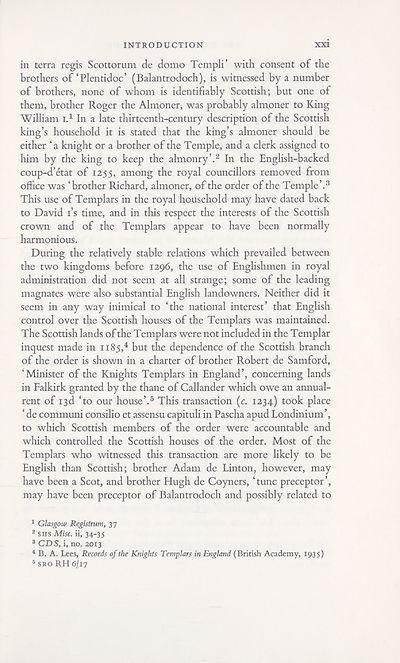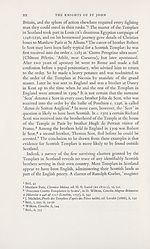Series 4 > Knights of St John of Jerusalem in Scotland
(26) Page xxi
Download files
Complete book:
Individual page:
Thumbnail gallery: Grid view | List view

INTRODUCTION
XXI
in terra regis Scottorum de domo Templi’ with consent of the
brothers of‘Plentidoc’ (Balantrodoch), is witnessed by a number
of brothers, none of whom is identifiably Scottish; but one of
them, brother Roger the Almoner, was probably almoner to King
William i.1 In a late thirteenth-century description of the Scottish
king’s household it is stated that the king’s almoner should be
either ‘a knight or a brother of the Temple, and a clerk assigned to
him by the king to keep the almonry’.2 In the English-backed
coup-d’etat of 1255, among the royal councillors removed from
office was ‘brother Richard, almoner, of the order of the Temple’.3
This use of Templars in the royal household may have dated back
to David i’s time, and in this respect the interests of the Scottish
crown and of the Templars appear to have been normally
harmonious.
During the relatively stable relations which prevailed between
the two kingdoms before 1296, the use of Englishmen in royal
administration did not seem at all strange; some of the leading
magnates were also substantial English landowners. Neither did it
seem in any way inimical to ‘the national interest’ that English
control over the Scottish houses of the Templars was maintained.
The Scottish lands of the Templars were not included in the Templar
inquest made in 1185,4 but the dependence of the Scottish branch
of the order is shown in a charter of brother Robert de Samford,
‘Minister of the Knights Templars in England’, concerning lands
in Falkirk granted by the thane of Callander which owe an annual-
rent of 13d ‘to our house’.5 This transaction (c. 1234) took place
‘ de communi consilio et assensu capituli in Pascha apud Londinium’,
to which Scottish members of the order were accountable and
which controlled the Scottish houses of the order. Most of the
Templars who witnessed this transaction are more likely to be
English than Scottish; brother Adam de Linton, however, may
have been a Scot, and brother Hugh de Coyners, ‘tunc preceptor’,
may have been preceptor of Balantrodoch and possibly related to
1 Glasgow Registrum, 37
2 shs Misc. ii, 34-35
3 CDS, i, no. 2013
4 B. A. Lees, Records of the Knights Templars in England (British Academy, 1935)
5 sro RH 6/17
XXI
in terra regis Scottorum de domo Templi’ with consent of the
brothers of‘Plentidoc’ (Balantrodoch), is witnessed by a number
of brothers, none of whom is identifiably Scottish; but one of
them, brother Roger the Almoner, was probably almoner to King
William i.1 In a late thirteenth-century description of the Scottish
king’s household it is stated that the king’s almoner should be
either ‘a knight or a brother of the Temple, and a clerk assigned to
him by the king to keep the almonry’.2 In the English-backed
coup-d’etat of 1255, among the royal councillors removed from
office was ‘brother Richard, almoner, of the order of the Temple’.3
This use of Templars in the royal household may have dated back
to David i’s time, and in this respect the interests of the Scottish
crown and of the Templars appear to have been normally
harmonious.
During the relatively stable relations which prevailed between
the two kingdoms before 1296, the use of Englishmen in royal
administration did not seem at all strange; some of the leading
magnates were also substantial English landowners. Neither did it
seem in any way inimical to ‘the national interest’ that English
control over the Scottish houses of the Templars was maintained.
The Scottish lands of the Templars were not included in the Templar
inquest made in 1185,4 but the dependence of the Scottish branch
of the order is shown in a charter of brother Robert de Samford,
‘Minister of the Knights Templars in England’, concerning lands
in Falkirk granted by the thane of Callander which owe an annual-
rent of 13d ‘to our house’.5 This transaction (c. 1234) took place
‘ de communi consilio et assensu capituli in Pascha apud Londinium’,
to which Scottish members of the order were accountable and
which controlled the Scottish houses of the order. Most of the
Templars who witnessed this transaction are more likely to be
English than Scottish; brother Adam de Linton, however, may
have been a Scot, and brother Hugh de Coyners, ‘tunc preceptor’,
may have been preceptor of Balantrodoch and possibly related to
1 Glasgow Registrum, 37
2 shs Misc. ii, 34-35
3 CDS, i, no. 2013
4 B. A. Lees, Records of the Knights Templars in England (British Academy, 1935)
5 sro RH 6/17
Set display mode to:
![]() Universal Viewer |
Universal Viewer | ![]() Mirador |
Large image | Transcription
Mirador |
Large image | Transcription
Images and transcriptions on this page, including medium image downloads, may be used under the Creative Commons Attribution 4.0 International Licence unless otherwise stated. ![]()
| Scottish History Society volumes > Series 4 > Knights of St John of Jerusalem in Scotland > (26) Page xxi |
|---|
| Permanent URL | https://digital.nls.uk/126637827 |
|---|
| Description | Over 180 volumes, published by the Scottish History Society, containing original sources on Scotland's history and people. With a wide range of subjects, the books collectively cover all periods from the 12th to 20th centuries, and reflect changing trends in Scottish history. Sources are accompanied by scholarly interpretation, references and bibliographies. Volumes are usually published annually, and more digitised volumes will be added as they become available. |
|---|


